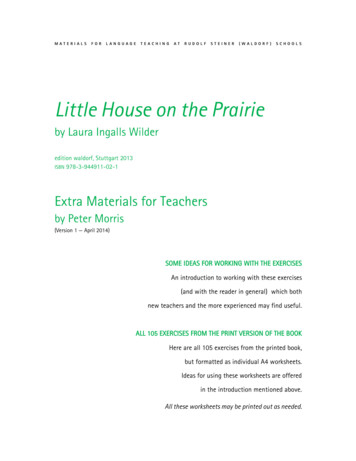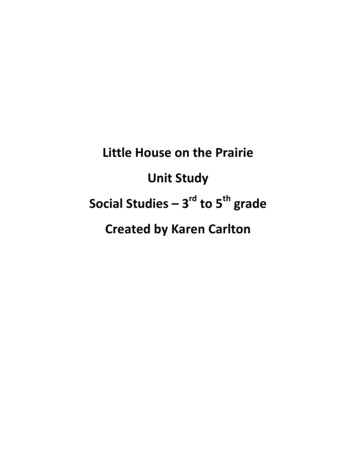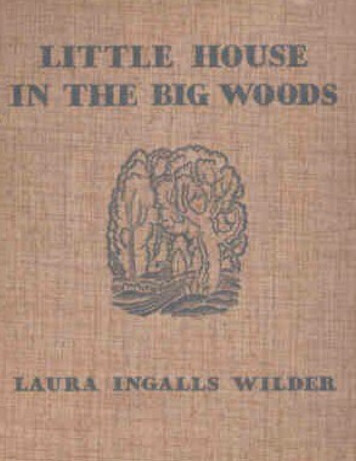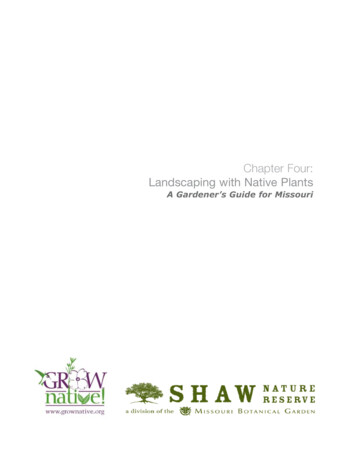
Transcription
MATERIALSFORLAN GUAGETEACHIN GATRUDOLFSTEINER(WALDORF)SCHOOLSLittle House on the Prairieby Laura Ingalls Wilderedition waldorf, Stuttgart 2013ISBN 978-3-944911-02-1Extra Materials for Teachersby Peter Morris(Version 1 — April 2014)SOME IDEAS FOR WORKING WITH THE EXERCISESAn introduction to working with these exercises(and with the reader in general) which bothnew teachers and the more experienced may find useful.ALL 105 EXERCISES FROM THE PRINT VERSION OF THE BOOKHere are all 105 exercises from the printed book,but formatted as individual A4 worksheets.Ideas for using these worksheets are offeredin the introduction mentioned above.All these worksheets may be printed out as needed.
Some ideas for working with the exercises forLittle House on the Prairie — and a few extrasDIFFERENT TYPES OF EXERCISEFirst, take a few minutes to look through the exercises and see how they’re structured. There are ten totwelve types which repeat in each chapter, often with a slowly increasing degree of complexity. At thelow end, this may only be that the verb form to be changed is always in italics at first, with the italicsomitted later so the kids have to consider what they’re supposed to be changing (this is not automaticfor everyone!).BUILDING SKILLSIf we want to build skills, rather than just practise a few sentences, we can try and teach the exercisetypes, for example:‘How do you do an Either / or exercise?’ Choose one of the two answers on offer. Make sure you write the words correctly — they’re there in the book (in the question, infact), so there’s no excuse for spelling “house” or “eight” wrongly. Where do you look to find the answers if you don’t know them straight off? It tells you inthe Exercise Heading, so you just have to look: EXERCISE 29 – EITHER/OR (PAGES 10–11).‘How do you do the “question word” exercises?’ The question word tells me what I’m looking for:who namewhat thing(s)where in/at/on etc. phrases, and so on and then you look for the key words of the question in the text.So for “Where did Ma and Pa pile everything from the wagon?” in Exercise 27 (Chapter 3)you’re looking for something like ‘in/on/at etc.’ with ‘everything.’ and ‘piled’.When you know this, you find the place on page 9, and the answer, ‘on the ground’ is rightthere. In this way, you can usually find all the answers even if you don’t know some of thewords (like ‘pile’). And of course, all these words can be checked with the help of theVocabulary Page by Page.‘What about the “Vocabulary” exercises? These are a bit different. As usual, the exercise heading gives the page numbers, forexample PAGES 9–11. Of course, pages 9–11 of the main text do have the words you need,but you probably won’t find them quickly.So here, you turn to the corresponding part of the Vocabulary Page By Page — in this case,the vocabulary for pages 9–11, which starts on page 58. For each question, you look forthe words in italics in the middle column of the vocabulary. The answer you need is in thelefthand column.WHY SHOULD THIS BE INTERESTING FOR THE KIDS?All of this needs technique and thus practice — the payoff for the kids is independence.Working with the exercises for Little House on the Prairie – and some extraspage 1 of 5
You say: Hier bei den Übungen weiß jeder einige Antworten einfach so. Aber was macht man bei denanderen Fragen? Soll man die Eltern fragen? Geschwister? Freunde anrufen? In der Pause abschreiben?Oder geht es, dass man selber die Antworten findet, auch ohne Genie zu sein?„Selbständig werden“ — that can be very attractive for young teenagers, particularly if you can showthem it needs some work, but not an incredible amount.STARTING WITH PARTIAL SENTENCESI tend to start all the exercises with partial sentences, for example “to drink from the creek” and not“The horses stopped to drink from the creek.”This may be anathema to some teachers, but it means you avoid, for the time being, the past tenseproblems (Where did they stop? They stopped ) which in this exercise at least, you are not actuallypractising, and get the kids mobile right away. You can graduate to complete sentences later, andthere are many, many exercises in the collection which practise just this. And it needs a LOT ofpractice!ORAL WORK FIRST – AND ITS PROBLEMSI like to do the exercises orally at first. All kids are different, but many of mine like to try and makenotes or coded pencil marks of what they hear to tell them the right answer at home, so they canavoid actually thinking and trying to remember. I hate being a ‘pencil policeman’ and have found thata neat way to avoid the problem is a circle of chairs at the front. The kids leave their places and cometo the front with only the copy of the exercise you give them. If there’s not much room, you can havethem sitting on the tables at the front, with you in the circle. (This can be awkward the first few times,but if you do it regularly, it gets much faster – and quieter!)This way it’s much easier to dispense with all writing implements, which means you can go throughpart or even all of the exercise in class (a big boost for the slower ones) and it’s still a sensiblehomework assignment. Or they can do it straight off in class. Slightly more difficult, concentration andlearningwise, is if you go through two different exercises at the front and then let them do both foryou.CIRCULATE THROUGH THE CLASS WHILE THEY’RE WORKINGWhile they are working you can go round, looking at their work, which helps you see where they’rehaving difficulty.For this to work well, you need a fairly concentrated work atmosphere, and this needs a few rules – youcan say, for example, No walking around or coming over to talk to me. But if you raise your hand I’ll comeover as soon as possible. No doing nothing, while you wait for me to arrive – you should go on withwhatever next questions you can manage, or even a different exercise.SILENT SIGNALS?If you like, you can have silent signals, like tapping a word in their work once, meaning perhaps, “this isan easily avoidable mistake which you can correct if you look at the text again,” or tapping it three times,which might mean, “this is not a silly spelling mistake, but it’s wrong. Why? Please think — try and findthe answer, then wave and I’ll come back over.”THE EXERCISE CAFETERIAYou can also do exercises more than once. For example, if you’ve practiced five different types and arein Chapter 2, you could announce the next lesson as an ‘Exercise Cafeteria.’ You print up the sheetsyou need, the front row of desks is the buffet, and the kids come and choose their exercises. For eachWorking with the exercises for Little House on the Prairie – and some extraspage 2 of 5
type, they take the Chapter 1 exercise and the one from Chapter 2. Back to their places and write;when they’re finished, they give you the pages and take the next exercises. This can go on for most ofa lesson and is generally much enjoyed. Casting a fast glance over the pages you’re given also givesyou the chance to call some back , saying, ‘Julian ’ and do your tapping signs. Patient repetition ofthis, I’ve found, can slowly help some of the kids to write (a little) more carefully.MORE CONCENTRATIONDoing the things orally first, with no coded homework-help signs possible, and then written, can reducethe discussion time in class, which can often be unconcentrated and unfruitful, in favour of actuallydoing the work, concentrating on how to get the answer, and then maybe doing it again, some timelater. “Developing Selbständigkeit” — put like this, the prospect of repetition doesn’t irritate as itotherwise might. So, when you’re in Chapter 3, you could say: OK, next lesson, I want you to write mefour exercises from Chapters 1 and 2 (or just Chapter 2). I choose 2, you choose two. Or make a game ofit: I choose 1, you choose 1 or 2, and 1 or 2 come from a big pot-luck pile of exercises lying face-down.The kids pick what they need, returning doubles they already have. And so on EXTRA TASKS — NOT JUST FOR FASTER STUDENTSIf you have introduced the different types of exercises with your class, as recommended here, then thefirst choice for ‘extra tasks’ will be those exercises for the chapter being worked on which you haven’tselected for the whole class. But you have other options, too: Give (or ask the student to choose) exercises not done by the class from previous chapters. You can ask for a repetition of exercises from earlier chapters in various stages of difficulty.The easiest form is just a written repeat; a little more difficult is a written repeat in classwithout referring to the work done earlier; still more difficult is an oral presentation to theclass with no notes, only the book (or worksheet, unannotated) in front of the student. You aren’t restricted to previous chapters only: some types of exercise can be done withouthaving read the story. Consider vocabulary exercises, for example, or anything to do withchanging tenses or forming questions, negatives and normal statements. If you have several students doing the extra work, then you can give it as a ‘team task’.Here, each student might do three questions of each of four different exercises. This meansthe students are doing a wider range of tasks, but still only 10–15 questions, plus thepresentation to the class is much more interesting, as the ball is passed from student tostudent. You can have student A do questions 1,2 & 3 of each exercise, student B numbers4, 5 & 6 and so on; or you can mix things up completely: student A does numbers 1, 4 & 7;student B numbers 2, 5 & 8; student C takes 3, 6, 9 & 10. When selecting exercises for extra work, you don’t have to confine yourself to singlechapters. You can select a type of exercise from various chapters, and do these in the sameway — for example, Past tense exercises from the last three or four chapters, or Questionforming. You can ask for complete exercises or just a selection of answers: perhaps10–15from three or four exercises. Common sense rules apply: they can choose which questionsto answer, but if exactly the same verb-forms pop up repeatedly, this doesn’t count! For most students, the ‘Did you understand the chapter?’ exercises are among the hardest. Ifyou have some very confident students, ask them to prepare answers at home and thenpresent them orally in class. Interview form: teacher or another student asks the questions,no notes allowed for the answers— i.e. the answers must not be read out!Working with the exercises for Little House on the Prairie – and some extraspage 3 of 5
If you need to lead up to this stage more easily, then you can have students do this exercisein written form first, which you correct and give back. This is a solid basis for their‘interview preparation’ beforehand. Or they can make notes for their answers beforehand,which you then check through with them, suggesting improvements. Or, (for shorter workwith some moral support), let two friends prepare the same exercise — half each,alternating answers. To ‘sugar the cake’ somewhat, you can tell the kids that those prepared to do extra tasksnow and again („freiwillige Zusatzaufgaben”) will have it mentioned in their end-of-yearreports. This in my experience is something which impresses most parents (“My teenager volunteering !”). The kids know this very well, but the offer is by no means a bribe, but areport on something well worth praising!HOMEWORKMy five homework-blocks per week of Sprachepoche tended to be something like: learning vocabulary – counting two homework-blocks. one or two exercises, either from the reader or separate grammar exercises (which you cantreat in a similar way to that described above). and one (or two) blocks practicing or learning something which is to be done in the lesson.This can also be a Prairie exercise or two:A USEFUL VARIANT OF ‘EXERCISES FOR HOMEWORK’The variant here is that the kids don’t write the exercise(s) at home, as per classic homework-method,but prepare the work at home and then do it in class, with or without the book as you like.It’s a little more of a ‘test’ atmosphere, as opposed to the ‘workshop’ atmosphere described above.This lets you winnow out those who bring you perfect work which has in fact been done by someoneelse, and lets you see more quickly who can do what and who needs more help, attention,encouragement or prodding EXTRAS – FOR EXAMPLE, READING PRACTICEAny extras, like dictations (very occasionally ) or reading practice, can be fitted in ad hoc. Withreading practice, you need to stagger the assignments. If you tell the whole class to practice, even theslowest will see that you can’t possibly check twenty kids in one, or even two lessons. So then some, orquite a few, will take a chance and not practice. So you say, Over the next three weeks, everyone is going to practice. And I’ll listen to you reading —one or two per lesson. Choose a page (or twenty lines, or whatever) — it doesn’t have to be from line 1 on, youcan start anywhere. If you volunteer, you can choose your date (as far as possible). Otherwise, I’ll choose anddecide when you read. Who’d like to start the day after tomorrow? I’ll be making notes on what I hear; anyone who wants can ask me what my notes abouthim were. (Asking what other people’s notes were is of course not allowed.) My reactions will be on a one to one basis, though I may make a few exceptions with openpraise if some people are particularly good Working with the exercises for Little House on the Prairie – and some extraspage 4 of 5
‘Pace’ — how fast should I go with the reader?CONSIDER THE TIMETABLEI don’t know if you have ‘Epochen’ (blocks of lessons, five per week, over two to three weeks,alternating with French, making five lessons/week over half the year) or the classic model of threelessons per week throughout the year. My school has the ‘Sprachepochen’ — six per year ofvarying lengths — and I tended to do two chapters in the longer periods and one in the shorter —eight chapters in the whole of Prairie.VARY THE PACEIt’s a good idea to vary the pace a bit: doing everything in great detail makes for creepingpedantry, while skimming through everything will dilute interest after a time.FOCUSSED WORK & MOVING FASTERPick out parts of the chapter that you want to focus on in more detail and go through the restmore quickly.SOME CONCRETE SUGGESTIONSWith three lessons a week I would in general read twice, with the five Epochen-lessons three tofour times, but here again you can vary: one lesson you can spend most of your lesson on thetext, another time on the text and doing exercises. Yet again, you can read and do some oralwork, but maybe only for ten to fifteen minutes.SOME EXAMPLES OF VARIATIONYou want a varied path in length of reading too: every lesson with the same structure and timedivisions gets boring very quickly. On the other hand, total improvisation is just chaotic. So youcould have various ‘models’, for example: a ’focus on reading’ lesson, using some exercise questions just orally; the shorter reading and oral exercises; the written exercises (in class, as practice — see above).TO SUM THINGS UPThere is no magic formula, but the principle is structured variation: of pace of concentration of detail, or focus of length of timeWorking with the exercises for Little House on the Prairie – and some extraspage 5 of 5
Little House On The Prairie(Chapter 1 — Going West)EXERCISE 1 — WHAT & WHERE (PAGES 4–5)1.What did Pa and Ma and the others leave in the Big Woods?.2.Where were they going?.3.Where did they make camp almost every night?.4.Where did they sometimes stay several days?.5.What did they drive across on long bridges?.6.What did they drive onto, to cross the Missouri River?.7.Where did the wagon stick fast in deep mud?.8.Where was there to build a camp and make a fire?.9.What was damp and cold?.10. What did they have to eat?.
Little House On The Prairie(Chapter 1 — Going West)EXERCISE 2 — MAKE NORMAL STATEMENTS (PAGES 4–5)Example:1.They didn’t drive away from the house. They drove away from the house.The horses didn’t travel as far as they could.2.Pa and Ma didn’t make camp every night.3.They didn’t see strange woods and hills.4.Pa didn’t drive onto a raft.5.The wagon didn’t stick fast in mud.6.Pa didn’t find a place where they could camp.7.They didn’t have to wait a week.8.Pa didn’t talk to the man on the pony.9.They didn’t go off into the woods together.10. The two men didn’t come back riding black ponies.
Little House On The Prairie(Chapter 1 — Going West)EXERCISE 3 — EITHER / OR (PAGES 4–5)1.When they came to the Missouri River, was there a long bridge, orwas there no bridge?.2.Did the wagon cross the Missouri on a raft or on a bridge?.3.Did the wagon stick fast on the hills or in a valley?.4.Did the rain stop next day or a week later?.5.Did the tall man come over the creek or out of the woods?.6.When he first came, was he riding a black pony or a brown horse?.7.Who did the brown horses belong to at first — Pa or the tall man?.8.Which animal is bigger — a horse or a mustang?.9.Who gave the name ‘Pet’ — Laura or Mary?.10. Who gave the name ‘Patty’ — Pa or Mary?(Be careful!).
Little House On The Prairie(Chapter 1 — Going West)EXERCISE 4 — PUT INTO THE PAST TENSE (PAGES 5–6)Example:1.Pa drives onto a raft. Pa drove onto a raft.In a valley, the wagon sticks fast in mud.2.Rain pours down.3.There is nowhere to make camp.4.They all have to stay in the wagon.5.Next day Pa finds a place to camp.6.While they are waiting, a man comes out of the woods.(Two verbs!).7.Pa says the little horses are western mustangs.(Two verbs!).8.Kansas is an endless flat land.9.All day they see nothing but the grass and the sky.10. Baby Carrie sleeps in the back of the wagon.11. Each night they camp in a different place.
Little House On The Prairie(Chapter 1 — Going West)EXERCISE 5 — MAKE THESE STATEMENTS NEGATIVE (PAGES 5–6)Example:1.The Missouri had a bridge. The Missouri didn’t have a bridge.They came to the Missouri again.2.They had good weather.3.The rain stopped quickly.4.They ate warm food that night.5.They waited just one day.6.The water in the creek went down very fast.7.Pa wanted to keep the tired brown horses.8.The mustangs were brown.(Be careful! What does ‘were’ do?).9.Kansas was a land full of hills.(Be careful! What does ‘was’ do?).10. They camped in the same place every night.
Little House On The Prairie(Chapter 1 — Going West)EXERCISE 6 — DOLMETSCHEN (PAGES 4–5)Folgende Sätze sind alle im Text zu finden. Oft musst du aber ein paar Wörter weglassen!1.Manchmal mussten sie an einem Lagerplatz bleiben.2.Ein Bach hatte Hochwasser, und sie konnten ihn nicht überqueren.3.Sie saßen alle im Wagen, während das Floß das(!) Wasser überquerte.4.In einem Tal blieb der Wagen fest in tiefem Schlamm stecken.5.Sie mussten in dem Wagen kaltes Essen zu sich nehmen.6.Während sie warteten, kam ein Mann auf einem Pony aus dem Wald heraus.7.Pa tauschte die braunen Pferde gegen die schwarzen Ponys aus.8.Kansas war ein endloses, mit Gras bedecktes Land.9.Tag für Tag sahen sie nichts außer dem Gras und dem Himmel.10. Jede Nacht schlugen sie ihr Lager an einem anderen Ort auf.
Little House On The Prairie(Chapter 1 — Going West)EXERCISE 7 — MAKE THESE SENTENCES INTO QUESTIONS (PAGES 5–6)Example:1.The wa
Little House on the Prairie. by Laura Ingalls Wilder . edition waldorf, Stuttgart 2013 . ISBN. 978-3-944911-02-1 . Extra Materials for Teachers . by Peter Morris (Version 1 — April 2014) SOME IDEAS FOR WORKING WITH THE EXERCISES An introduction to working with these exercises (and with the reader in general) which bothFile Size: 915KB










